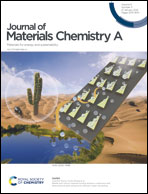Rare earth metal La-doped induced electrochemical evolution of LiV3O8 with an oxygen vacancy toward a high energy-storage capacity†
Abstract
Due to its high theoretical capacity (∼280 mA h g−1), lithium vanadium oxide (LiV3O8) is considered a promising electrode material for meeting the demands for a longer battery life. However, it still suffers from an inferior cycling stability and rate properties. Benefitting from the unique traits of rare earth metal La, La-doping was introduced to V-sites, leading to an expansion of the lattice volume and reduced particle size, and bringing about more oxygen defects for fast ion redox reactions. The considerable discharge capacity of optimized La-doped LiV3O8 could reach up to 308 mA h g−1, and the capacity could be kept at 252 mA h g−1 after numerous loops. Supported by a detailed analysis of the capacity curves, an improved redox activity of V5+ was strongly demonstrated. Moreover, compared to the basic materials, an increasing rate capacity located in the low potential range was detected, ascribed to the existence of an oxygen vacancy, enabling a reduction in the energy barrier and a broadening of the energy distribution. Interestingly, La-doping could ultimately improve the capacity and is thus worth further exploration, particularly for the design of advanced cathodic materials.



 Please wait while we load your content...
Please wait while we load your content...